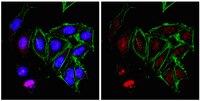Reduced RAN expression and disrupted transport between cytoplasm and nucleus; a key event in Alzheimer's disease pathophysiology.
Mastroeni, D; Chouliaras, L; Grover, A; Liang, WS; Hauns, K; Rogers, J; Coleman, PD
PloS one
8
e53349
2013
Zobrazit abstrakt
Transcription of DNA is essential for cell maintenance and survival; inappropriate localization of proteins that are involved in transcription would be catastrophic. In Alzheimer's disease brains, and in vitro studies, we have found qualitative and quantitative deficits in transport into the nucleus of DNA methyltransferase 1 (DNMT1) and RNA polymerase II (RNA pol II), accompanied by their abnormal sequestration in the cytoplasm. RAN (RAs-related Nuclear protein) knockdown, by siRNA and oligomeric Aβ42 treatment in neurons, replicate human data which indicate that transport disruption in AD may be mechanistically linked to reduced expression of RAN, a pivotal molecule in nucleocytoplasmic transport. In vitro studies also indicate a significant role for oligomeric Aβ42 in the observed phenomena. We propose a model in which reduced transcription regulators in the nucleus and their increased presence in the cytoplasm may lead to many of the cellular manifestations of Alzheimer's disease. | 23308199
 |









